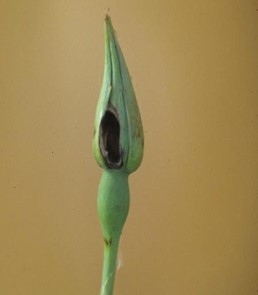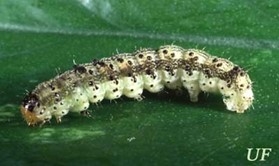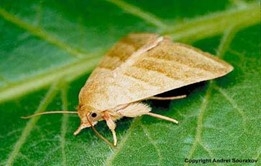- Author: Richard Hardwick
- Author: Laura Berger
Introduction

The tobacco budworm will bore into the flower buds. Look for the caterpillar or its frass inside the buds. The caterpillar is under one-inch long, green, yellow or brown with white or black markings. The adult moth has a wing span of about 1½ inches and is brown/green in color.
According to the University of California, budworms feed on geraniums, petunias, snapdragons and roses as well as a lot of agricultural crops, fruits and vegetables, and many horticultural plants. Evidence of their arrival are tiny round or oblong 1/16-inch holes in flower buds, 1/8-inch holes in leaves and blooms, and black seed-like droppings. Flowers that open after budworm infestation have damaged petals and a budworm can destroy several flowers per day. The plant may cease flower production completely if severely infested. The budworm may move on to consume leaves and foliage also. The budworms peak in late summer. When mature, the larva drops to the ground and pupates in the soil. They can have 2 to 4 generations in a season, overwinter in the soil, and emerge as a moth again during the next growing season.
Management
Use Integrated Pest Management (IPM) for successful plant problem management.
Non-chemical management

Manage weeds in and around gardens to remove the habitat and alternate food sources for the tobacco budworm.
Monitor plants closely for damage. Handpick and destroy larvae and infested buds on roses. Hand pick caterpillars or prune out and promptly dispose of infested buds or rolled leaves (often hiding caterpillars within).
Scout for larvae at dusk, when they are most active. Check for actively feeding larvae, small holes in buds and flowers, and caterpillar droppings (frass or feces) associated with damaged buds.
Chemical management

Bacillus thuringiensis (Bt) is somewhat effective if applied when eggs or damage are first noticed. However, Bt must be consumed by young, actively feeding larvae and only works where the young larvae are feeding on the SURFACE of the plant. Bt is NOT effective against larvae feeding within buds and will not provide reliable control of mature larvae.
Damage is usually not severe and treatment with pesticides not generally necessary. Leaf-feeding caterpillars can be reduced with the microbial insecticide Bacillus thuringiensis or the insecticide Spinosad. These materials will be most effective when caterpillars are small, however caterpillars within buds are unlikely to be killed. Damage may not be noticed until after caterpillars are full grown and no longer vulnerable to insecticide applications.
References
https://ipm.ucanr.edu/PMG/PESTNOTES/pn7466.html
https://entnemdept.ufl.edu/creatures/field/tobacco_budworm.htm
https://www.gardeningknowhow.com/ornamental/flowers/roses/budworms-roses.htm
https://ucanr.edu/datastoreFiles/268-758.pdf
https://hortsense.cahnrs.wsu.edu/fact-sheet/rose-tobacco-budworm/

